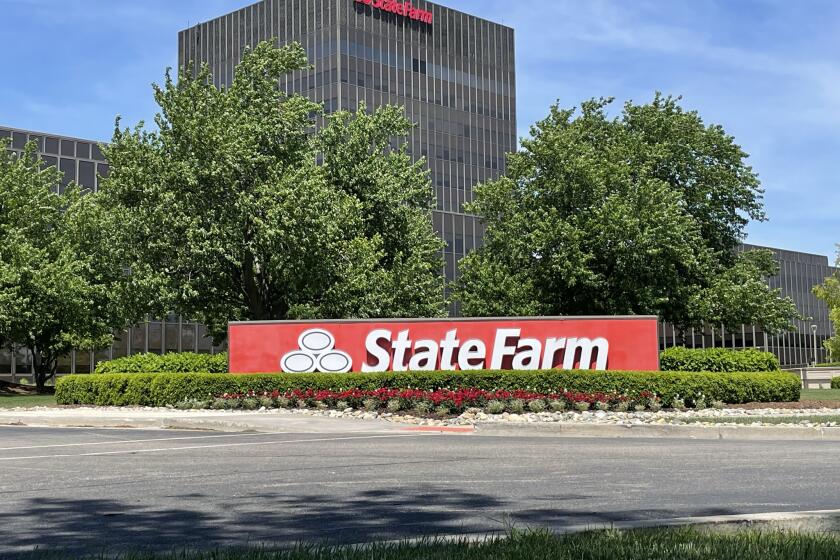Inflation cooled again last month as grocery and gas prices fell, few signs of tariff impact yet

- Share via
WASHINGTON — Inflation cooled for the third straight month in April even after some of President Trump’s tariffs took effect, though economists and many business owners expect inflation will climb in the coming months.
Consumer prices rose 2.3% in April from a year ago, the Labor Department said Tuesday, down from 2.4% in March and the smallest increase in more than four years. On a monthly basis, prices rose modestly, increasing 0.2% from March to April after falling 0.1% the previous month, the first drop in five years.
Grocery prices dipped 0.4%, pulled downward in part by a big 12.7% fall in the price of eggs. It was the biggest decline in food costs at home since September 2020, the government said.
The report suggests the tariffs haven’t yet impacted the prices of many items. Clothing costs fell 0.2% from March to April, while new car prices were unchanged. Furniture costs jumped 1.5%, however.
Excluding the volatile food and energy categories, core prices were also muted, rising 2.8% in April compared with a year ago, the same as in March. On a monthly basis, they increased a mild 0.2%. Economists watch core prices because they typically provide a better read on where prices are headed.
Only some early tariffs imposed by Trump were in effect in April, including 25% duties on steel and aluminum and 25% on some imports from Canada and Mexico. Trump’s initial 20% import taxes on goods from China were also in place. The steel and aluminum duties will take time to affect consumer products, such as cars, and may not affect retail prices for months.
Trump announced a universal 10% tariff that took effect April 5. His huge 145% import taxes on Chinese goods were reduced to 30% in a deal announced Monday.
Still, economists say average tariffs are now at about 18%, roughly six times higher than before Trump took office and the highest in about 90 years.
Items that were already in transit when the tariffs were imposed won’t have to pay the duties, while many companies have built a stockpile of goods and could hold off on price hikes in hopes that tariffs will ultimately be reduced.
Still, some companies have raised prices and others have said they plan to do so as a result of the duties. Mattel Inc., the maker of Barbie dolls and Hot Wheels cars, said earlier this month it would have to raise prices on some products to offset tariffs. The company makes 40% of its products in China.
Tool maker Stanley Black & Decker said it raised prices in April and plans to do so again in the July-September quarter because of higher tariffs. And executives at Procter & Gamble, the consumer products giant that makes household name brands such as Crest toothpaste, Tide detergent, and Charmin toilet paper, said last month it will likely have to pass on higher prices to consumers as soon as July.
Consumer prices cooled noticeably in February and March, prompting Trump to claim repeatedly on social media that there is “NO INFLATION.” Inflation has fallen to nearly the 2% target set by the Federal Reserve, the agency charged with fighting higher prices.
The smaller import taxes on Chinese goods will limit the damage to the U.S. economy, but combined with all the other tariffs, economists forecast they will still slow growth this year and worsen inflation.
The Yale Budget Lab, for example, estimates the tariffs will lift prices 1.7% and cost the average household about $2,800 this year.
And while Trump may tout his trade deals — such as the one with the United Kingdom reached last week — he has also said “tariffs is the most beautiful word” in the dictionary, and is counting on revenue from duties to narrow the budget deficit, suggesting tariffs will likely remain high.
The tariffs have also put the Federal Reserve in an exceedingly difficult spot, as Chair Jerome Powell acknowledged in a news conference last week. Powell said the duties have raised the risk of both higher inflation and higher unemployment, two challenges that rarely occur simultaneously. If unemployment rose, the Fed would typically cut rates to boost the economy, while if inflation worsened, the central bank would usually raise rates or leave them elevated.
Rugaber writes for the Associated Press.
More to Read
Inside the business of entertainment
The Wide Shot brings you news, analysis and insights on everything from streaming wars to production — and what it all means for the future.
You may occasionally receive promotional content from the Los Angeles Times.










